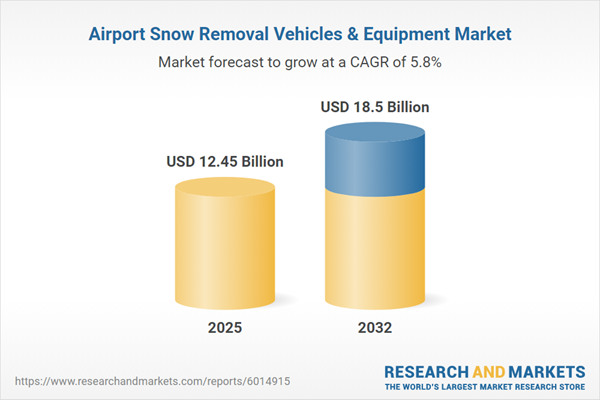Speak directly to the analyst to clarify any post sales queries you may have.
Effective airport snow removal is essential for maintaining operational reliability and compliance, especially in regions regularly affected by severe winter weather. Leaders guiding airside operations must anticipate disruption, prioritize safety, and ensure regulatory alignment amid evolving environmental expectations.
Market Snapshot: Airport Snow Removal Vehicles & Equipment Market
The global airport snow removal vehicles and equipment market is projected to increase from USD 11.75 billion in 2024 to USD 12.45 billion in 2025, and ultimately reach USD 18.50 billion by 2032, reflecting a CAGR of 5.83%. Growth is supported by robust investments in advanced airside solutions, digital connectivity for asset management, and the development of modern vehicle powertrains. Enhanced telematics and adaptive power systems are improving the resilience of airport infrastructure, while regulatory shifts and sustainability goals are prompting airports to transition to environmentally responsible fleets. Collaborative partnerships between airports and suppliers play a key role in ensuring extended equipment uptime and widespread adoption of technical advancements across diverse airport profiles.
Scope & Segmentation
- Equipment Types: Deicing vehicles, anti-icing sprayers, snowplows, multi-stage blowers, wing plows, air blast machines, deicing trucks, and specialized sweepers address a variety of airfield clearing scenarios for efficient snow and ice removal.
- Vehicle Types: Self-propelled tracked equipment, wheeled units, and trailer-mounted platforms are selected to match infrastructure configurations and operational demands from international airports to small regional airfields.
- Power Sources: Diesel engines, battery electric systems, hybrid units, and hydrogen fuel cell technologies support emission reduction strategies and compliance initiatives in response to stricter sustainability mandates.
- Applications: Targeted snow and ice clearance operations on aprons, runways, taxiways, and in specialized deicing zones ensure safety, regulatory adherence, and maintain flight schedules.
- End Users: Public airports, private aviation operators, and contracted maintenance firms depend on reliable snow removal to maintain airfield availability within different management frameworks.
- Geographies: Market presence spans the Americas, Europe, Middle East, Africa, and Asia-Pacific, with solutions tailored for varying climates, operational complexities, and local regulatory requirements.
- Key Companies: Leading manufacturers and solution providers include Oshkosh Corporation, Terex Corporation, Bucher Industries AG, AB Volvo, Komatsu Ltd., Shanghai Construction Machinery Co., Ltd., Zoomlion Heavy Industry Science and Technology Co., Ltd., JBT Corporation, Textron Inc., and Deere & Company, all delivering specialized technology at scale.
Key Takeaways for Senior Decision-Makers
- Automation and telematics facilitate predictive deployment, boosting fleet readiness and enabling faster, more coordinated winter response strategies at airports of all sizes.
- Transitioning toward alternative powertrains and lower-emission technologies is fundamental for meeting current and future environmental and social governance commitments.
- Implementing modular, flexible snow removal systems allows airports to adapt quickly to changing conditions, maintaining both operational efficiency and runway availability.
- Procurement practices reflect regional preferences, with certain markets emphasizing system scalability and others focusing on innovative efficiency aligned with modernization objectives.
- Active collaboration with suppliers expedites technical enhancements, elevates maintenance standards, and supports proactive asset lifecycle management amid ongoing regulatory changes.
Tariff Impact: Implications of U.S. Tariff Adjustments in 2025
Recent tariff modifications in the United States have increased acquisition costs for both vehicles and key components in the airport snow removal segment. In response, procurement leaders are diversifying supplier networks, evaluating nearshore manufacturing options, and renegotiating contract terms to maintain supply chain stability and ensure consistent fleet upgrades in a shifting procurement environment.
Methodology & Data Sources
This market analysis incorporates structured feedback from airport operators, original equipment manufacturers, and commercial winter service providers. Findings are validated through legislative review, technical documentation, and established market modeling, delivering thorough and actionable insights to stakeholders.
Why This Report Matters
- Equips decision-makers with benchmarking capabilities to select suppliers and remain informed on region-specific and international compliance requirements.
- Supports investment planning, lifecycle management, and regulatory preparedness to strengthen operational resilience throughout the winter season.
- Delivers actionable, segmented data that facilitate tailored approaches to technology investment, user needs, and regional climate conditions in airport environments.
Conclusion
This analysis guides airport leaders in making informed procurement and operational choices, providing a solid foundation as snow removal technology and regulatory landscapes continue to evolve.
Additional Product Information:
- Purchase of this report includes 1 year online access with quarterly updates.
- This report can be updated on request. Please contact our Customer Experience team using the Ask a Question widget on our website.
Table of Contents
3. Executive Summary
4. Market Overview
7. Cumulative Impact of Artificial Intelligence 2025
Companies Mentioned
The companies profiled in this Airport Snow Removal Vehicles & Equipment market report include:- Oshkosh Corporation
- Terex Corporation
- Bucher Industries AG
- AB Volvo
- Komatsu Ltd.
- Shanghai Construction Machinery Co., Ltd.
- Zoomlion Heavy Industry Science and Technology Co., Ltd.
- JBT Corporation
- Textron Inc.
- Deere & Company
Table Information
| Report Attribute | Details |
|---|---|
| No. of Pages | 187 |
| Published | October 2025 |
| Forecast Period | 2025 - 2032 |
| Estimated Market Value ( USD | $ 12.45 Billion |
| Forecasted Market Value ( USD | $ 18.5 Billion |
| Compound Annual Growth Rate | 5.8% |
| Regions Covered | Global |
| No. of Companies Mentioned | 11 |









